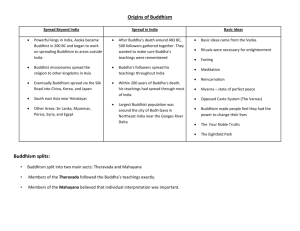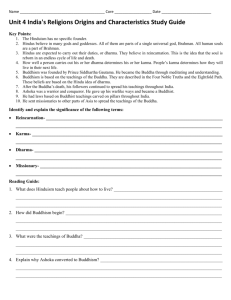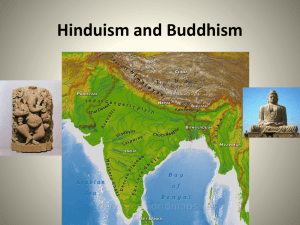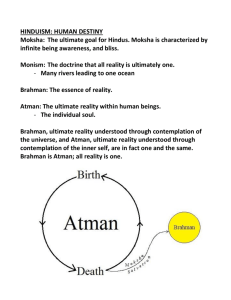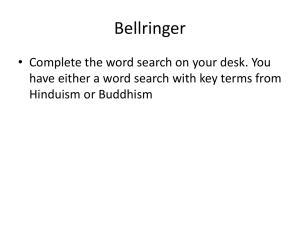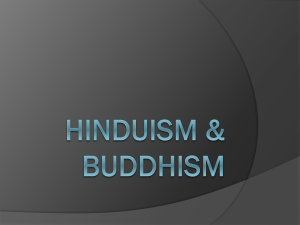The Elements of Culture Defining Culture World Geography and Cultures Chapter 4
advertisement
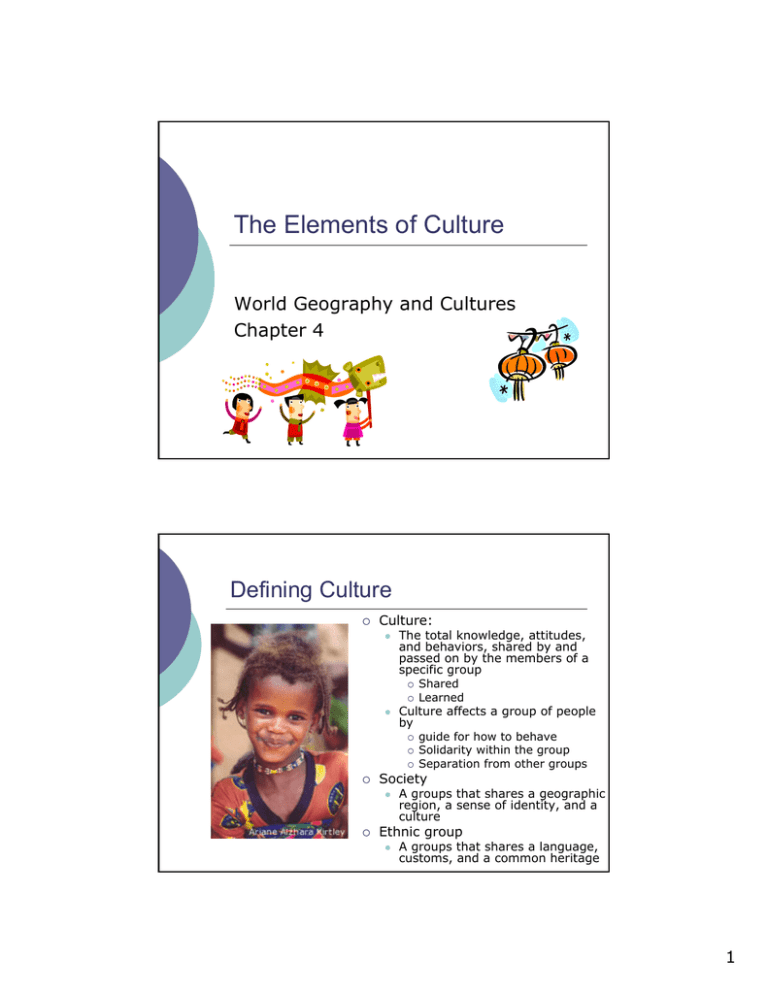
The Elements of Culture
World Geography and Cultures
Chapter 4
Defining Culture
{
Culture:
z
The total knowledge, attitudes,
and behaviors, shared by and
passed on by the members of a
specific group
{
{
z
Culture affects a group of people
by
{
{
{
{
guide for how to behave
Solidarity within the group
Separation from other groups
Society
z
{
Shared
Learned
A groups that shares a geographic
region, a sense of identity, and a
culture
Ethnic group
z
A groups that shares a language,
customs, and a common heritage
1
Defining Culture
{ What
elements of American
culture unite us?
Huli (Papua New Guinea
Maori (New Zealand)
Padaung (SE Asia)
Cultural Change
{
Cultures and societies are always in
the process of changing (not always
fast)
z
z
Innovation
Diffusion
2
Innovation & Invention
{
Taking existing technology and resources and
creating something new to meet a need
z
z
{
Often innovation and invention work side by side to
create changes
z
{
Accident (innovation)
Observation and experimentation (invention)
Ex: agriculture may have begun as accident, but
quickly improved because of invention.
Examples: innovation or invention?
z
z
z
z
z
Fire
The Wheel
Boats
Levers and pulleys
Farming & herding
Diffusion
{
The spread of ideas,
inventions, or patterns of
behavior
z
Early diffusion occurred
{
{
z
Today, the Internet and TV
play an important part in
cultural diffusion
{
{
{
Along trade routes
Through personal contact
Where do you think diffusion
happens less frequently?
Besides the Internet and TV,
what are some other modern
agents of diffusion?
Culture Hearth
z
This is the site of innovation
from which basic ideas,
materials, and technology
diffuse to many cultures
{
River civilizations
z
Nile, Indus, Tigris/Euphrates,
Huang He.
3
Acculturation
{
When a society
changes because it
accepts or adopts an
innovation
z
{
Ex: wearing jeans
instead of traditional
clothing
Sometimes
individuals or a group
will adopt innovations
that radically change
the society
z
Positive and/or
negative ramifications
Language
{
One of the most
important aspects of
culture
z
z
{
Communication within
the culture
Reflects the culture
{ Bias & beliefs
{ Physical
characteristics
Language helps
establish a cultural
identity
z
z
Fosters nationalism
Divisive factor
4
Language Families
{
{
3,000-6,500 different
languages spoken today
worldwide
Language families
z
z
{
Groups of similar
languages with common
origins
About 13 major language
families
Dialects
z
Version of a language
which reflects changes in
speech patterns related
to
{
{
{
Class
Region
Other cultural
differences
Anatolian Hearth Theory
{
Origin of Indo-European languages
z
Nostratic
{ Anatolian Plateau = Turkey
{ Basis of modern Indo-European languages today
z
English, German, Russian, Hindi, Greek all have the same roots
5
Language Diffusion
{
Languages traveled and spread
around the world
z
Trade routes
{
Traders would learn local
languages and teach their own
languages
z
z
Eastern North America – Native
Americans had learned French
from the fur trappers
Invented
{
Language combinations
z
z
z
Swahili (Arabic + Bantu)
Spanglish (Spanish + English)
Louisiana Creole (African, French,
NA English)
z
Migrations
z
Foods
{
{
Colonial migration
Some of the first words diffused
of a language!
Religion
{
{
Religion consists of a
belief in a supernatural
power or powers that
are regarded as the
creators and
maintainers of the
universe
Characteristics of
religion
z
Established beliefs and
values
{
z
z
Supernatural
Worship and ritual
Social expectations and
solidarity
6
Major World Religions
{
South West Asia origins
z
{
South East Asia origins
z
z
{
z
z
Confucianism
Taoism (daoism)
Shinto
Other world beliefs
z
{
Hinduism
Buddhism
Other Asian practices
z
{
Judaism, Christianity,
Islam
Animism
Universalizing vs. Ethnic
Creativity and Cultural Expression
{
All cultures have ways of
expressing their values,
beliefs, and ideas in a
creative manner
z
z
{
Performing arts, visual
arts, literature (or oral
tradition)
Clothing and adornment
are also means of
creative expression
While some expressive
forms have a relationship
to cultural belief systems
(i.e. the Muslim veil) –
others began because
they “looked cool.”
7
Judaism
{
Oldest monotheistic religion
{
Ethnic religion
z
z
{
About 3,200 years old
Long tradition of faith and
culture
Basic laws and teachings
come from sacred text
z
Torah
{
{
Genesis – Revelations
Moses and Abraham
{
Holiest location
{
Influences
z
City of Jerusalem
z
Zoroastrianism
z
Slavic languages
{
{
Rembrandt
Persian religion
Yiddish was unique to the
Eastern European Jews
and was diffused with
their migrations
“Sacrifice of Abraham”
Christianity
{
Evolved about 2,000 years ago from Judaic
teachings
{
Text
z
z
Monotheistic
Old Testament
{
{
{
z
Torah
Genesis – Revelations (moved to the end of the
New Testament in the Christian text)
Jewish prophets and teachers
New Testament
{
Life and teachings of Jesus Christ
{
Jesus is believed by Christians to be divine
{
Largest of all three SW Asian religions
{
Holiest location
{
Three main branches
z
z
z
z
z
{
Madonna and Child, ca. 1300
Duccio di Buoninsegna
Over 2 billion followers
Jerusalem
Catholic
Protestant
Eastern Orthodox
Universalizing religion
Michelangelo
“the Pieta”
8
Islam
{
Originated in the early 7th century
z
Prophet Muhammad
{
{
Began teaching in 613 CE
Monotheistic
z
{
Text
z
Qur’an (Koran)
{
{
z
Sunni
Shiite
Holiest location
z
z
z
{
Same teachings and prophets as
the Torah and the Old Testament
Branches
z
{
Allah (same deity as Jewish and
Christian)
Mecca, Saudi Arabia
Medina, Saudi Arabia
Jerusalem
Universalizing religion
z
Spread through SW Asia, North
Africa, parts of the Balkans, and
across the Indian Ocean to SE Asia
Hinduism
{
One of the world’s oldest religions, Hinduism, is practiced by most
people in India today.
z
z
{
Brahman
z
z
z
Hinduism evolved over thousands of years and was influenced by the
cultures and traditions of many peoples.
However a few fundamental teachings are shared by nearly all Hindus.
Among most basic tenets of Hinduism,
belief in Brahman, eternal being that
created, preserves world
Brahman all-encompassing
Many believe human mind incapable of
understanding
{
Atman
z
z
z
Hindus believe each person has atman,
soul, aspect of Brahman
Atman shapes personality, cannot be
destroyed, even by death
Devas, manifestations of Brahman,
active in world, helping maintain order
in nature
Three devas- Brahma, Vishnu, Siva -are particularly influential. Some believe in
thousands; others worship only one as the true manifestation of Brahman.
9
Buddhism
{
{
Buddhism, which teaches people that they can escape the suffering
of the world through the Buddha’s teachings, developed in India and
spread to other parts of Asia and the world.
Buddhist Beliefs
z
z
z
z
{
Four Noble Truths
z
z
z
z
{
After enlightenment achieved, Buddha meditated at Bodh Gaya seven
weeks
Set out to spread to others what he had learned
Lessons became basic teachings of Buddhism
Among ideas learned in meditation, central truths, called Four Noble
Truths
Suffering part of human life
Suffering from people’s desires for pleasure, material goods
Overcoming desires during life eventually brings end to suffering
Desires can be overcome by following Eightfold Path
The Buddha taught that those who followed Eightfold Path
could attain nirvana
z
z
z
State of perfect peace in which soul freed from suffering forever
Those not attaining nirvana reborn to live through cycle of suffering again
Basic teachings of Eightfold Path, Middle Way — living in moderation,
avoiding extremes of comfort, discomfort in search for nirvana
10
